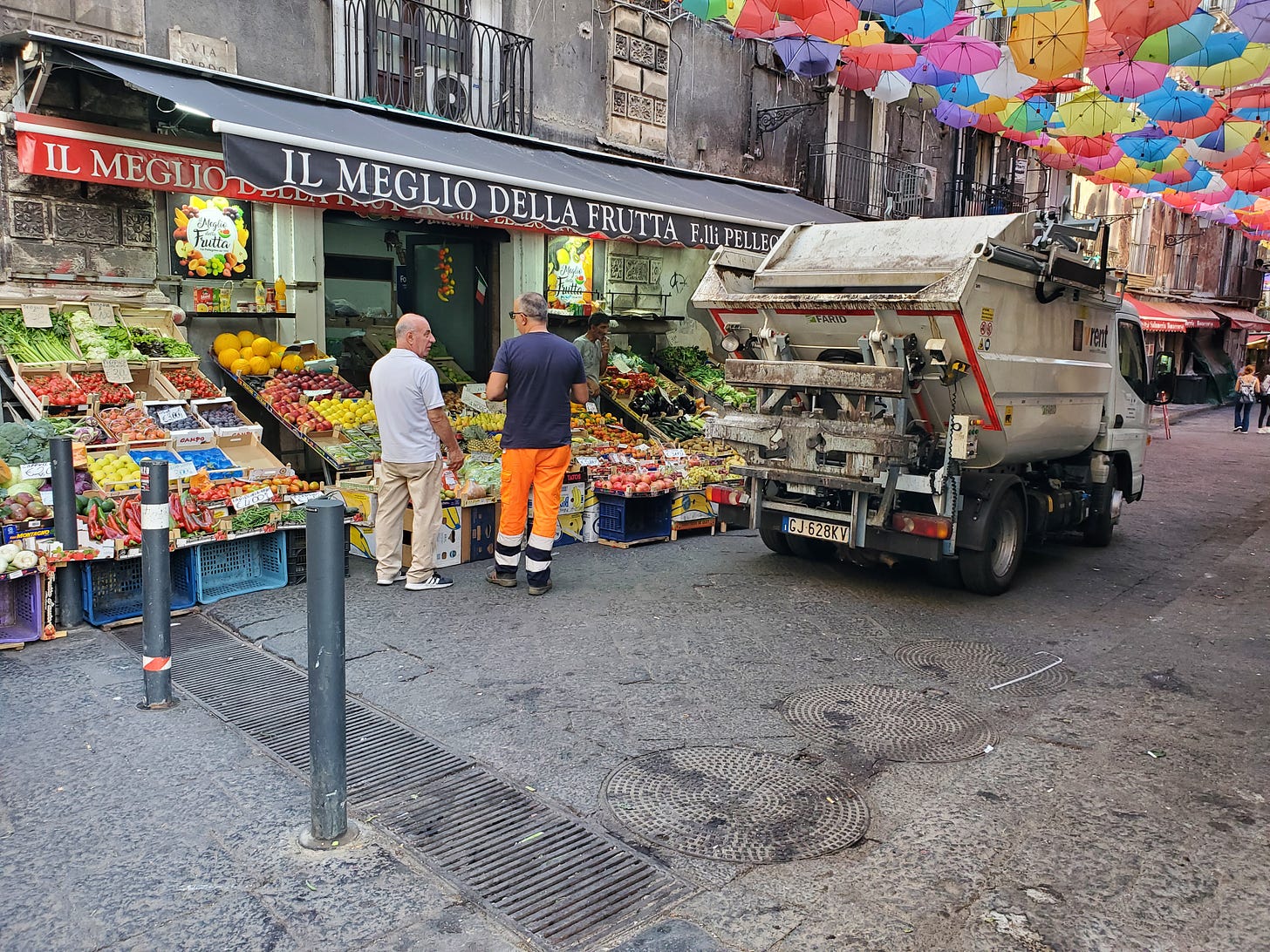Take a look at this picture I snapped in Catania, Sicily:
One of the men in the picture lifted those bollards out of the ground, let the tiny trash truck in, and replaced the bollards. Show this to the next person who says car-free streets are not workable because of trash and emergency service.
And these, from Ragusa and Siracusa:
This one from Taormina:
And this scooter-truck, also in Taormina, which turned into a fresh fish market in the middle of the street!
These are everywhere in Italy. They’re the same basic class of vehicle as the Japanese “kei trucks” that have been having something of a moment, thanks to a string of news stories. Vanishingly few vehicles like this are marketed in or made for the U.S. market—the majority that are in the U.S. have been imported by individuals or small firms. Some states, and some federal regulations, make this very tricky.
Some people love these baby trucks; some don’t. As for me, I’d love to see a lot more of them. As would, I think, most urbanists, who are frequently critical of the size of American vehicles. Not just the big gas-guzzling SUVs, but the massive fire trucks and garbage trucks and our other commercial and utility vehicles, which are a not-insignificant reason for our very wide residential streets, which in turn incentivize speeding and make neighborhoods less safe. (See these three pieces—here, here, and here—from Strong Towns on the vehicle size/road design interplay.)
You still might wonder, though: America doesn’t have ancient cities with streets that really need these kinds of vehicles. Aren’t our vehicles right-sized for the development pattern that prevails here? What difference does it make?
It’s kind of chicken and egg: it’s difficult to create new neighborhoods in this old, classically urban pattern—which many of us actually like!—because the vehicles to serve it simply do not exist readily in the U.S. market. The fire department will give you a hard time. Trash collection firms. What about the ambulances?
Meanwhile, the old cities that we do have are degraded by the presence of vehicles sized for sparse suburbs with wide streets. And this in turn reinforces the prevailing but sort-of wrong idea that cities are loud and chaotic. It’s almost like we’ve lost the “replacement parts” for real cities.
Vehicles and streets—transportation networks and development patterns—exist in symbiosis. In some sense, they’re the same thing. They’re part of an ecosystem. So there’s a grain of truth to the idea that “that wouldn’t work here,” whether we’re talking about building genuine urban streets, or importing or making vehicles sized for such built environments.
This whole question of speeds, street widths, and vehicle sizes is interesting. But what really struck me about Italy’s tiny trucks was their symbiosis with small-scale enterprise.
I’ve been developing this idea that the scale of everything in America is too big, or, at least, starts too big. We have big things: big-box stores, big houses, big cars, wide roads. We have medium-sized versions of these things. But we mostly lack the very small.
We don’t have small city-sized cars, tiny homes or no-frills housing for people starting out or people who need a roof. We don’t make it easy for individual people to be developers or business owners—storefronts attached to homes, little corner stores or stores in nooks, home-based businesses, backyard cottages. When you think about all of these things as interconnected, you start to see that America is missing something like the bottom third of the “scale ladder.”
Look at that Italian fishmonger who can sell fish in the street because he can access a small van with the guts of basically a glorified motorcycle but the capacity of what in America would be a huge, expensive vehicle. (And because the streets are tame, it’s safe.) Multiply this by a thousand, and think about how this changes the whole fabric and culture of how business is done. And think about how much individual entrepreneurship, initiative, and enterprise America effectively closes off.
I’m not engaging in a philosophical “small is beautiful” argument here. There are real, tangible, concrete benefits to scaling things—cities, vehicles, regulations—for people, so that individuals can do things. Small may or may not mean “beautiful.” But it means getting a foothold. It means opportunity. It means flexibility. It means options. It’s the opposite of barriers for people who don’t have a lot.
Let me leave you with something I wrote recently, which lines up exactly with this piece:
We now view as trappings of poverty what we once viewed as engines of opportunity. We lose tolerance for discomfort, for gradual and incremental improvement, for making do, for being hardscrabble and resourceful.
And, in turn, we make life artificially and needlessly harder for those who are still willing to exercise those virtues, or who have not become affluent enough to dispense with them.
What do people say when you talk about small cars or tiny houses? Who wants that anyway? I don’t know. Maybe nobody after all. But I’m not afraid to find out.
Related Reading:
Thank you for reading! Please consider upgrading to a paid subscription to help support this newsletter. You’ll get a weekly subscribers-only piece, plus full access to the archive: over 800 pieces and growing. And you’ll help ensure more like this!











I'm obsessed with Japan's tiny fire trucks and feel like they'd be ideal for creeping through many of our older alleys.
I want to buy a Fiat500 which currently is not for sale (but will be next year.) And there are really no other options that are that small. A smart car is a tiny bit too small for me, I want to very occasionally throw a kid in the back seat and ... I have basically zero choices ugh :(.